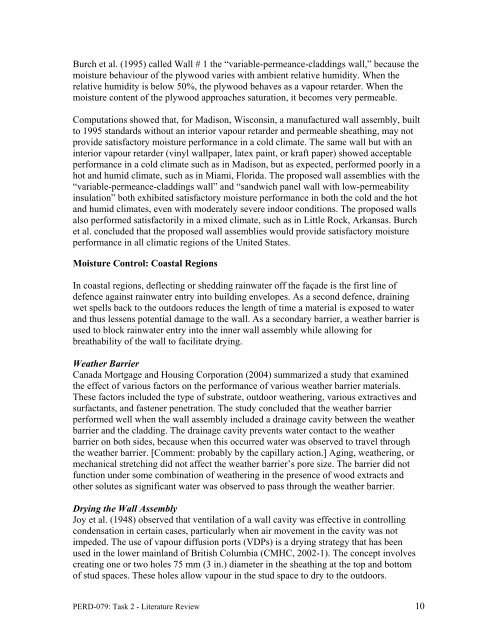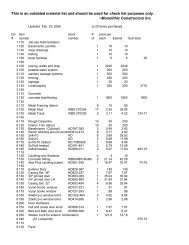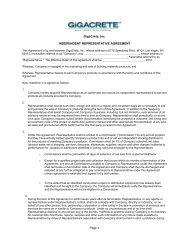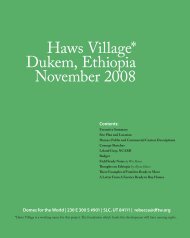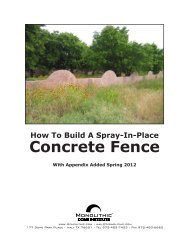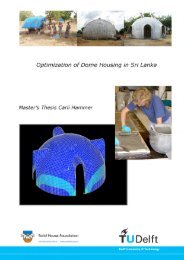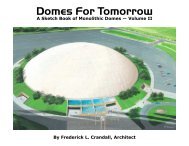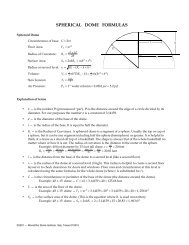Literature Review on Building Envelope, Heating and ... - Beeshive.org
Literature Review on Building Envelope, Heating and ... - Beeshive.org
Literature Review on Building Envelope, Heating and ... - Beeshive.org
Create successful ePaper yourself
Turn your PDF publications into a flip-book with our unique Google optimized e-Paper software.
Burch et al. (1995) called Wall # 1 the “variable-permeance-claddings wall,” because the<br />
moisture behaviour of the plywood varies with ambient relative humidity. When the<br />
relative humidity is below 50%, the plywood behaves as a vapour retarder. When the<br />
moisture c<strong>on</strong>tent of the plywood approaches saturati<strong>on</strong>, it becomes very permeable.<br />
Computati<strong>on</strong>s showed that, for Madis<strong>on</strong>, Wisc<strong>on</strong>sin, a manufactured wall assembly, built<br />
to 1995 st<strong>and</strong>ards without an interior vapour retarder <strong>and</strong> permeable sheathing, may not<br />
provide satisfactory moisture performance in a cold climate. The same wall but with an<br />
interior vapour retarder (vinyl wallpaper, latex paint, or kraft paper) showed acceptable<br />
performance in a cold climate such as in Madis<strong>on</strong>, but as expected, performed poorly in a<br />
hot <strong>and</strong> humid climate, such as in Miami, Florida. The proposed wall assemblies with the<br />
“variable-permeance-claddings wall” <strong>and</strong> “s<strong>and</strong>wich panel wall with low-permeability<br />
insulati<strong>on</strong>” both exhibited satisfactory moisture performance in both the cold <strong>and</strong> the hot<br />
<strong>and</strong> humid climates, even with moderately severe indoor c<strong>on</strong>diti<strong>on</strong>s. The proposed walls<br />
also performed satisfactorily in a mixed climate, such as in Little Rock, Arkansas. Burch<br />
et al. c<strong>on</strong>cluded that the proposed wall assemblies would provide satisfactory moisture<br />
performance in all climatic regi<strong>on</strong>s of the United States.<br />
Moisture C<strong>on</strong>trol: Coastal Regi<strong>on</strong>s<br />
In coastal regi<strong>on</strong>s, deflecting or shedding rainwater off the façade is the first line of<br />
defence against rainwater entry into building envelopes. As a sec<strong>on</strong>d defence, draining<br />
wet spells back to the outdoors reduces the length of time a material is exposed to water<br />
<strong>and</strong> thus lessens potential damage to the wall. As a sec<strong>on</strong>dary barrier, a weather barrier is<br />
used to block rainwater entry into the inner wall assembly while allowing for<br />
breathability of the wall to facilitate drying.<br />
Weather Barrier<br />
Canada Mortgage <strong>and</strong> Housing Corporati<strong>on</strong> (2004) summarized a study that examined<br />
the effect of various factors <strong>on</strong> the performance of various weather barrier materials.<br />
These factors included the type of substrate, outdoor weathering, various extractives <strong>and</strong><br />
surfactants, <strong>and</strong> fastener penetrati<strong>on</strong>. The study c<strong>on</strong>cluded that the weather barrier<br />
performed well when the wall assembly included a drainage cavity between the weather<br />
barrier <strong>and</strong> the cladding. The drainage cavity prevents water c<strong>on</strong>tact to the weather<br />
barrier <strong>on</strong> both sides, because when this occurred water was observed to travel through<br />
the weather barrier. [Comment: probably by the capillary acti<strong>on</strong>.] Aging, weathering, or<br />
mechanical stretching did not affect the weather barrier’s pore size. The barrier did not<br />
functi<strong>on</strong> under some combinati<strong>on</strong> of weathering in the presence of wood extracts <strong>and</strong><br />
other solutes as significant water was observed to pass through the weather barrier.<br />
Drying the Wall Assembly<br />
Joy et al. (1948) observed that ventilati<strong>on</strong> of a wall cavity was effective in c<strong>on</strong>trolling<br />
c<strong>on</strong>densati<strong>on</strong> in certain cases, particularly when air movement in the cavity was not<br />
impeded. The use of vapour diffusi<strong>on</strong> ports (VDPs) is a drying strategy that has been<br />
used in the lower mainl<strong>and</strong> of British Columbia (CMHC, 2002-1). The c<strong>on</strong>cept involves<br />
creating <strong>on</strong>e or two holes 75 mm (3 in.) diameter in the sheathing at the top <strong>and</strong> bottom<br />
of stud spaces. These holes allow vapour in the stud space to dry to the outdoors.<br />
PERD-079: Task 2 - <str<strong>on</strong>g>Literature</str<strong>on</strong>g> <str<strong>on</strong>g>Review</str<strong>on</strong>g> 10


